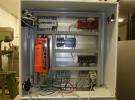I have a rudimentary monitoring system set up with a previous unit but now have a T7 Pro -
I would like to interface a sensor coil (analog magnitometer) in the quietest and widest dynamic range mode possible - coil is typically connected as a balanced source and is about 4k Ohm dc resistance - (45,000 turns on a 1" core 30" long). Frequency range of interest is 0.01 Hz to about 40 Hz. If the upper limit were reduced to as little as 20 Hz it would still be an improvement over my current arrangement. There is significant signal at 60 Hz from AC utilities -
Typical signals of interest range from a microvolt (or less) to over a volt during seismic activity.
Suggestions? Best input configuration for this?
I am also looking for the ability to display a 24 hour spectrum display - which seems like an equally difficult challenge for a rookie.
This is a personal hobby lab - so expensive software suites are out -
The T7 will also have an Epi Sensor triaxial sensor attached - but those outputs are straight forward balanced signals from the sensor's internal processing board. It is inherently a dc to ~200Hz bandwidth but the DC to 40 Hz is of most interest.
The Epi Sensor runs in its highest gain mode and is able to display the lunar influence on the z-axis acceleration.
Any guidance wil be greatly appreciated
Mark



.png%3Fitok=PHGBxf6M)


.jpg%3Fitok=B1YcuDFK)
.png%3Fitok=Ybt-OlgU)
Unfortunately, we do not have any particular recommendations for the spectral analysis. The solutions we are most familiar with are paid options such as MATLAB, LabVIEW, and 3rd party post-processing software. A likely solution would be to do the analysis after logging in a programming language with good math and graphing libraries. Python and R are two options that come to mind. You could handle the logging side with our Windows based LJLogM software:
https://labjack.com/support/software/applications/t-series/ljlogm
My initial recommendation for the AIN setup would be to start by sampling both signals with the 16-bit ADC at resolution index 8 and ±10V range. Resolution index 8 will provide oversampling and averaging to help filter out noise and you will be able to use a high enough data rate to avoid aliasing. The following data rates page is useful for understanding typical sampling rates under various AIN settings: